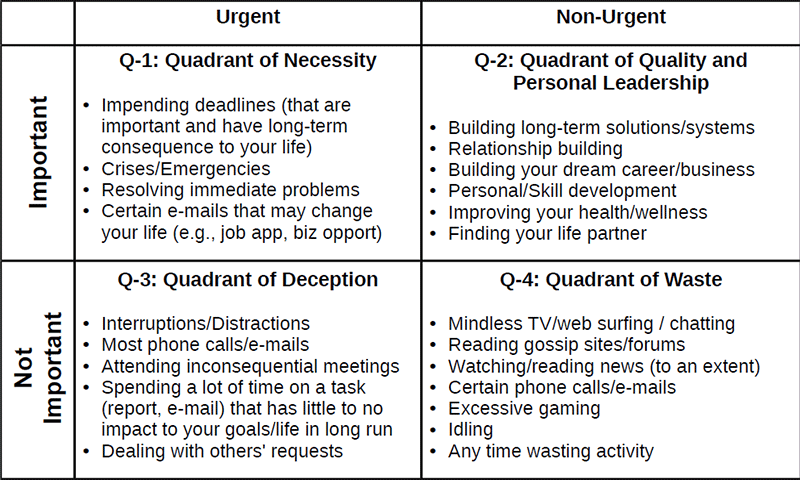Want to be successful? This is how successful people put first things first.
The Time Management Matrix is also known as the Eisenhower Matrix. It was created by Dwight D. Eisenhower, the 34th president of the United States, and was later popularized by Stephen Covey in his book, The 7 Habits of Highly Effective People.
Using The Time Management Matrix, our daily activities can be broken down into 4 Quadrants, sorted by urgency and importance:

4 Quadrants of the Time Management Matrix along with examples (Image © Personal Excellence)
Quadrant 1: Quadrant of Necessity
You will find your crises or emergencies here. Quadrant 1 screams for our attention because of its urgent and consequential nature.
However, many people fall into the trap of getting caught up in Q1. By spending all our time here, we become consumed with firefighting every day instead of crisis prevention. Side effects include stress, burnout, constant firefighting, and resolving problems instead of preventing them in the first place. We often see working level employees, advertising executives, accountants, etc. getting consumed by this quadrant.
Quadrant 3: Quadrant of Deception
Some people spend a lot of time dealing with Q3 tasks and confusing them with Q1 tasks. They think the tasks are important when they are not. For example, you may be spending a lot of time on a certain report that does not have any effect on your overall job performance or appraisal. Or you constantly attend meetings that have no value-add. This is why Q3 is called the Quadrant of Deception. Many times, the urgency of these tasks are due to others’ priorities or needs.
yourself: “Is this task related to my goals? Does doing this make any difference to me?” Focusing on Q3 results in short-term focus, being out of control of your life, and not being able to stick with your goals and plans.
Quadrant 4: Quadrant of Waste
This is called the Quadrant of Waste, and for good reason — it contains all your time wasters. People living unconsciously have a tendency to hover around Quadrants 3 and 4. After resolving their Q3 tasks, they enter auto-pilot mode and spend all their time in Q4. This can be because they have nothing better to do or they are procrastinating on the things they should be doing. Quadrant 4 creates no value in our lives whatsoever. Focusing on Q4 results in irresponsible behavior and dependency on other people.
Quadrant 2: Quadrant of Quality and Personal Leadership
Q2 is the magic quadrant we need to focus on. It is the most important quadrant, yet the most often neglected one.
Q2 is about having personal leadership and focusing on the important tasks that matter. Q2 tasks reflect your life goals and desires, which are linked to your life purpose. To correctly define them, you need to be clear on your life purpose first— so if you have not discovered your life purpose, please read my 7-part series on How to Find Your Life Purpose!
There are two reasons why Q2 tasks are often neglected: Firstly, Q2 tasks never become urgent until it is too late. For example, taking care of your health or pursuing your dreams. Secondly, compared to other quadrants, these tasks require more investment of energy and time to see results, which conflicts with modern society’s obsession with instant results.
However, Q2 tasks reap the most reward in the long run. Think about it as sowing seeds for future harvest.
- Imagine you are a lawyer whose dream job is to be a literature teacher (Q2 task). While working as a lawyer, you start studying for a degree in literature. You also take up teaching courses. While these will take a few years until completion, you have planted the seed. You know it is a matter of time before you will enjoy the harvest — being a full-fledged teacher.
- Another example would be relationships. Maybe you desire to get into a rewarding, long-term relationship (a Q2 task). Acting on this Q2 goal means starting the conscious search for a relationship partner. Even though it may take you a while before you find someone you like, you will experience benefits earlier than if you procrastinate on this.
After you plant your seeds, you will need to continuously water and care for them. However, it is a matter of time before you can reap the rewards of your labor. On the other hand, if you keep on putting off these Q2 tasks, everything will remain the same, whether it’s 5, 10, or 20 years from now. Focusing on your Q2 will create vision, perspective, balance, and control.
Think about all the things you do on a typical day. Now, classify them into their respective quadrants. How time and effort do you spend on each quadrant? Are there any tasks in your Quadrant 2 that you are neglecting? Strengthening your relationship with your family perhaps? Finding your life partner? Improving your health? Or investing in personal development?
To be effective, you need to consciously alter your behavior in the following ways:
- Q-1 Tasks: Manage immediately to get them out of the way. Spend the required effort such that they do not blow out of portion.
- Q-2 Tasks: Focus disproportionately due to the high payoff from the investment.
- Q-3 Tasks: Delegate to other people due to their urgent nature, but be minimally involved as they are not important.
- Q-4 Tasks: Dump them as they are neither important nor urgent.
Source: Personal Excellence



Comments
Post a Comment